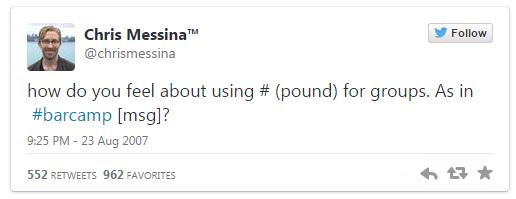At first it was a Twitter exclusive, but now we see the hashtag trend swept up by Facebook, Instagram and Vine, to name but a few. The hashtag is used to link posts, articles, videos; you name it, to any topic.
Some popular hashtag trends over the years include #MH370 (following the disappearance of Malaysian Airlines flight 370 on March 8, 2014), #RoyalBaby (following the birth of Prince William’s heir in 2013). But it does not solely extend to newsworthy stories, people hashtag when they are watching TV e.g. #familyguy or to join an on-going trend e.g. #throwbackthursday or even to salute the food they are eating e.g. #starbucks #coffee. In short, the hashtag is there to categorise information.
The first ever hashtag by a Google employee who wanted to create a way of grouping information on social media:

By adding a hashtag to your posts, you join a global conversation. But instead of just creating your own left right and centre, it is important that you know how to use this little character. Learn how to create your own trends and learn how to properly join a trend – lest you spam!
Here are some tips on how to join the conversation:
- Slow down
You don’t need to use multiple hashtags to be effective, just one, used in the right context, can do the job – the rule of thumb, never use more than three per post. - Research trends
Where you can easily see and research trending hashtags on Twitter (using the ‘Trends’ sidebar for example), use a platform, like Tagboard to research any other hashtags which you have in mind to add to your post. This helps you see if the hashtag is trending (which means more exposure to your post) or if there is a similar alternative you can use instead. - Carefully create your own
It’s advisable to create your own hashtags if you are, for example, hosting or attending an event. You can encourage others attending to use your hashtag also and create brand exposure that way. You can also opt for real-time content. See our article Taking a Bite of the Real-Time Marketing Cookie.
[Back]
blog comments powered by Disqus
